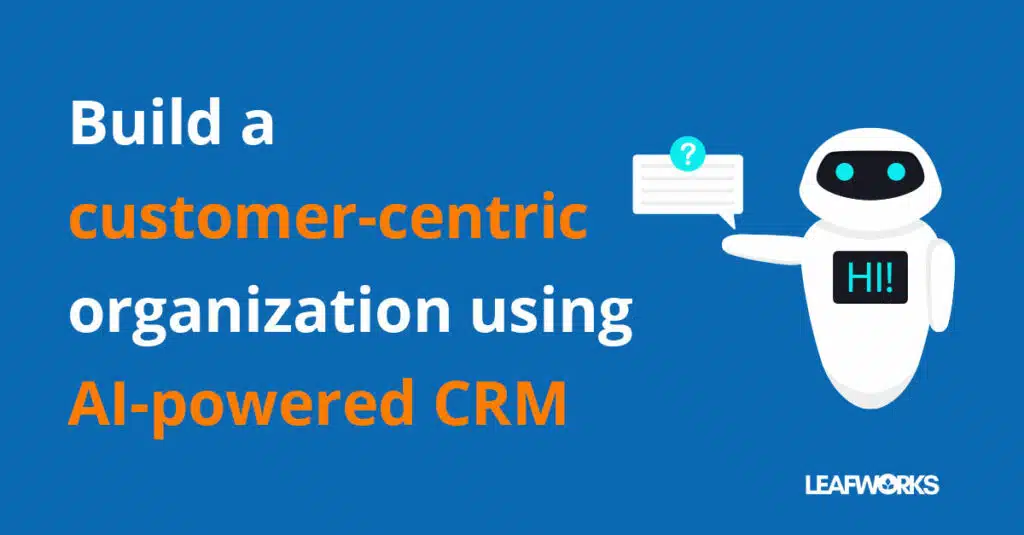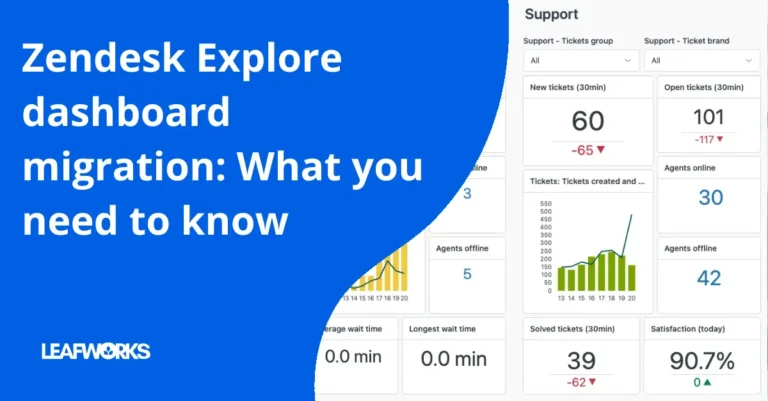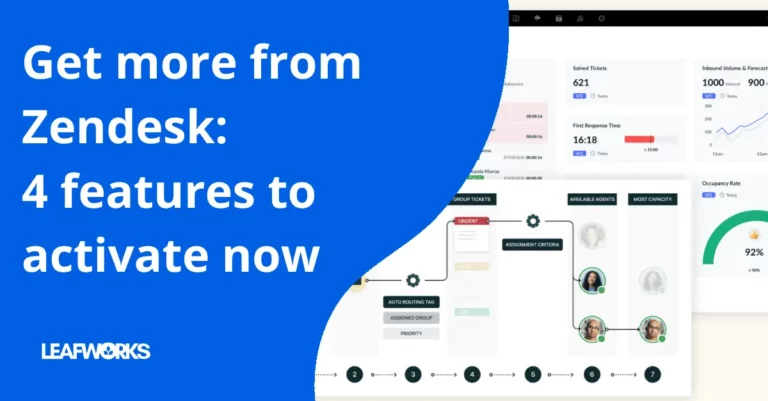According to the Zendesk CX 2022 Trends Report, 61% of customers are now willing to walk away after just one bad customer service experience. This number rose by 22% since 2021 and the report further states that after two negative experiences, 76% of customers now won’t come back.
When it comes to offering customers the personalized and responsive experience they’re looking for, the common dilemma businesses face is they tend to implement partial integration solutions out of urgent necessity or knee-jerk attempts to maintain a competitive edge. Oftentimes, software solutions used across departments double up on features, are expensive and don’t play well together, and businesses pay the ultimate price when customers disengage from brands as a result of one or two negative experiences.
So how do you ensure you are implementing the best enterprise resource planning (ERP) and customer relationship management (CRM) solution for your business that will make customers fall in love with your brand?
The answer lies in customer-centricity.
Here’s why the customer should always come first:
There’s a lot of talk about “being customer-centric”, but what does that really mean? Customer centricity is the philosophy that the needs of the customer should always come first. This might seem like common sense, but in order to be truly customer-centric, businesses need to adopt systems and processes that allow them to put customer needs at the centre of everything an organization does.
It is a customer-centric approach and culture of doing business that focuses on offering a positive customer experience at both the point of sale and after the sale in order to drive sustainable growth, and profit and gain a competitive advantage. When done well, customer-centricity has a number of benefits for businesses, such as:
- Increased customer satisfaction and loyalty
- Improved customer lifetime value
- Increased cross-selling and upselling opportunities
- Reduced customer churn
- Greater efficiency and productivity gains for staff members
Customer-centric company culture is when an organization’s staff members focus on customer needs and desires while interacting with customers. For customer teams to do this well, they need integrated data at their disposal in real-time and they need a good understanding of when and how to use the tools available.
Customers are the beating heart of businesses – they’re in the helpdesk, on the phones, in emails and in the sales system, logistics and post-sales support. The customer can be brought into focus in a customer-centric manner with AI-enabled ERP solutions and AI-enabled CRM systems to support data transparency by making real-time data easily accessible across an organization.
An example: with the help of technology, the world’s largest retailer Walmart changes prices every hour on a number of items.
Put yourself in your customers’ shoes. If you were the customer, what would you want?
Most people would say they’d want their needs to be put first, and that’s exactly what customer-centricity is all about. It means putting the customer front and center of all processes and decisions.
Listen, Grasshopper…
In order to ensure that your customers are happy, it’s important to listen to them. Listening allows businesses to understand not just what customers want today but also where they see themselves in the future. And when companies tap into this valuable information, they’re able to create products and services that cater specifically to their needs.
Customer satisfaction is essential for business success because it drives brand loyalty. Satisfied customers are more likely than others to remain loyal customers and tell their friends about their positive experiences with your company or product. In fact, according to a Nielsen survey conducted in 2012, 92% of people trust recommendations from friends and family over all other forms of advertising when making a purchase decision. The acquisition and retention of customers are key for any organization looking for long-term success, and customer-centricity is the best way to achieve that.
Customer satisfaction in an artificial world.
CRM systems that are integrated with AI-powered conversational marketing are a game-changer when it comes to customer service, as it allows businesses to provide a higher level of personalized service at scale. However, there are risks. The Zendesk CX 2022 Trends Report states that 57% of companies implementing AI solutions had an ad hoc approach to their AI strategy and only half can say that their teams are well-versed in emerging AI capabilities, which means “they’re largely shooting in the dark.”
The last thing any customer wants is for their service encounter to feel cold and mechanical…
In a digital world that craves connection, customers are demanding authenticity and expect prior experiences to influence future interactions. And they not only vote with their feet but also online with their reviews and social commentary.
Lose the mentality of bots replacing humans…
Just like in any other relationship, customers don’t like to repeat themselves or feel as though companies aren’t listening or learning from them and today’s winning companies are tapping into these basic human needs.
- Companies that are doing AI well are thinking about AI’s technological capabilities rather than how a bot might replace a human, focusing instead on what AI can do that a human can’t
- Using AI to complement and enhance human interaction rather than replacing it leads to a superior customer experience throughout the customer’s journey
When AI and humans work together, they are able to read between the lines to manage complex tasks and provide holistic solutions, all while building relationships with customers and creating loyal brand advocates. Utilizing an AI-powered CRM solution effectively with customer-centricity at the fore, you are able to create a 360-degree view of your customer which gives you the ability to offer them the best possible experience. While it might seem like a lot of work to set all of this up, the payoff is worth it.
Using AI-Powered CRM and ERP to bring a customer-centric organization to life.
The importance of communicating with customers in a personal way cannot be understated. You want to make sure that your business is using the right methods and tools for each customer, which helps you to build better relationships with them.
Encouraging a customer-centric culture in your organization has multiple facets. One component of a customer-centric culture is having an integrated ERP and CRM system with AI-powered conversational marketing capabilities across all customer communication channels:
- Chatbots
- Live chat (with humans!)
- SMS (bots or live)
- Social media messengers
- Phone
As many obstacles confront today’s businesses, an ERP system needs to provide a comprehensive omnichannel solution that links back-office, in-store, and customer experiences, enabling you to attract new customers while maintaining long-term relationships with existing ones. Customers must receive personalized and seamless shopping experiences, while businesses need higher employee productivity, fraud reduction, and revenue growth.
How can AI-powered CRM help organizations to provide personalized experiences to their customers?
In order to provide customers with a personalized experience, businesses need to segment their customers. Segmentation helps companies provide different customer experiences, which keeps them loyal to the brand over time. There are many ways to segment customers, but one of the most effective methods is by using AI-powered CRM software. AI-powered CRM can help organizations to provide personalized experiences to their customers in a number of ways. One way is by using customer segmentation to group customers based on similar characteristics so that you can tailor the customer experience to each group. For example, you might segment your customers by:
- Demographics (age, gender, location)
- Purchase history
- Engagement level
This way, you can make sure that each customer group is receiving the most relevant and personalized experience possible.
Harness the power of predictive analytics.
Another way AI-powered CRM can help to personalize the customer experience is by using predictive analytics to anticipate a customer’s needs and proactively provide them with the information or assistance they are likely to need. For example, a customer’s purchase history might be used to predict when they are likely to need a new product or service, and they can be proactively contacted about it.
Finally, AI-powered CRM can also help organizations to automate repetitive tasks so that employees can focus on more important tasks, such as providing a great customer experience.
Here’s how Instacart did it:
Instacart has identified two distinct customer bases, one of which is the personal shoppers and the other is the customers who are ordering for delivery. Instacart uses its CRM as a segmentation tool to differentiate between these two customer groups. Segmenting by customer type helps deliver a better experience to clients. For example, Instacart users and personal shoppers have different needs, requiring different information from the system.
A quick way to segment: if you only want to use software for customer segmentation, set up a simple automated phone routing menu. This will help your agents better serve your customers’ needs and give them a more personalized experience. Learn more about how we can help you to optimize your phone support here.
How can AI-powered CRM help organizations to engage their customers?
AI-powered CRM can help organizations to engage their customers in a number of ways. First, it can help to automate customer engagement tasks, such as sending emails, making calls or providing support. This means that human customer service representatives will be able to spend more time developing relationships with customers and helping them with more complex issues.
Additionally, AI-powered CRM can use machine learning algorithms to analyze customer data in order to identify trends and patterns. For example, sentiment analysis can be achieved in Zendesk using Natural Language Processing (NLP). This information can then be used to improve customer service, marketing campaigns and product development efforts. Finally, AI-powered CRM can also help organizations track the success of their customer engagement, marketing campaigns and product launches in order to determine what is working well and what needs improvement.
Setting up customer-centric processes and policies.
Implementing customer-centric processes and policies requires commitment! A customer-centric organization focuses on the needs of customers, employees, and suppliers. In some situations, the needs of all 3 groups are similar, while in others they appear to be at odds. In order to effectively implement customer centricity, you must establish processes and policies that support this way of working.
Looking through the customer window…
There are a few key customer-centric processes and policies that you can put in place to further improve the customer experience. The first is to create a customer feedback loop so that you can constantly be collecting data about the customer experience and using it to make improvements. This data can come from a variety of sources, such as:
- Customer surveys
- Net promoter score (NPS) surveys
- Customer service interactions
- User testing
Second, you need to have a process for handling customer complaints so that they are resolved quickly and to the customer’s satisfaction. This process should include a way to track customer complaints so that you can identify any patterns and make systemic changes to prevent them from happening in the future.
Finally, you need to make sure that you are constantly measuring and tracking customer satisfaction so that you can identify any areas where there might be room for improvement. There are a few different ways to do this, but one method is to use a customer satisfaction survey.
Nurturing a team for vibrant customer-centric brand culture.
Finding and nurturing leadership talent in your company can help your employees align with your company’s values of putting the customer first. If your employees are communicating with customers in an outstanding way, this can ultimately lead to increased revenue and better business performance. Therefore, rewarding talented employees will pay dividends in the long run. AI can do this in a number of ways by tallying staff achievements in innovative ways and providing and communicating opportunities to upskill and grow.
Managing supplier relationships from a customer-centric mindset.
Where a business can be really focused on customer service, including the supply of products and services, the supplier relationship can often be lightyears behind the rest of the company. AI-enabled ERP solutions can have the same positive impact on the supplier relationship as it does on the customer end. Improving supplier relationships has many benefits in stabilizing future success.
A solid technological infrastructure incorporating ERP software with AI technology can help to create seamless and easy experiences for your customers, employees and suppliers. By implementing these processes and policies, you will be well on your way to creating a customer-centric culture in your organization.
What are the challenges in building a customer-centric organization with AI-powered CRM?
There are many challenges that businesses face when trying to become customer-centric.
- Leadership Buy-in: One of the biggest is getting buy-in from leadership. Leaders need to be on board with a change in strategy and they need to understand how it will impact the company as a whole. In order for a customer-centric approach to succeed, they need to be willing to make changes to the way things have been done.
- Practical Strategy: Another challenge is creating a strategy that is practical over theoretical. Many times, businesses come up with ideas that look great on paper but are not feasible in the real world. Or, they create strategies that are too complex and difficult to put into action. One common mistake is that businesses spent months implementing a complex solution and implementation fails at the user end. Starting with a small project and learning and then continued implementation across more areas of the business based on that learning is the way to go.
- Customer Feedback: A lack of customer contact and feedback is another common issue companies face when trying to become customer-centric. Without this feedback, it can be difficult to know what customers want or need from your product or service. Communications between different departments can also be a challenge. For example, product development teams may not always be aware of what customer service is dealing with on a daily basis or vice versa.
- Measuring Metrics: Measuring the wrong metrics can lead companies astray when it comes time to assess their progress and success towards becoming customer-centric.
How does AI-powered CRM help organizations to know their customers better?
There are a variety of ways in which AI CRM can help organizations to know their customers better. One way is by using segmentation to understand the underlying customer problems that are driving customer requests. According to a study conducted by HBR (Harvard Business Review), AI-powered CRMs can also help identify potential new customers and opportunities for up to 50% more sales. In addition, they can make more informed decisions on whether or not to act on a request from a given customer. This helps organizations focus on the most important requests from their customers and improve customer satisfaction, engagement and retention rates.
What are the best practices for using AI-powered CRM for customer centricity?
There are a few best practices that must be followed in order to effectively use AI-powered CRM for customer-centricity. The first is to put the customer at the center of your development. This means understanding what they want and need, and then acting on that knowledge. It also requires building lasting relationships with customers, which is more difficult than just saying “the customer is top of mind.”
Customer-centric organizations take steps to understand the customer and act on that understanding. They focus on decision-making and process changes in order to create a culture of customer-centricity. And finally, they realize higher retention rates, more referrals, price premiums, and ultimately greater revenue with CRM adoption.
What are the trends in AI-powered CRM for customer centricity?
There is no doubt that AI-powered CRM can play a major role in customer-centricity. But what are the trends for this technology? Here are three of the most important ones:
- The use of predictive analytics to anticipate customer needs and wants. This will allow companies to provide relevant experiences before customers even realize they need them.
- Automation of processes that used to be manual, such as data entry and analysis, so that more time can be spent understanding customer behavior and preferences.
- Integration with other technologies, such as chatbots and social media listening tools, in order to get a holistic view of the customer’s experience.
How can AI-powered CRM help organizations improve customer retention?
It’s no secret that customer retention is important for organizations. In fact, it’s been shown that the probability of selling to an existing customer is 60-70%, while the probability of selling to a new prospect is only 5-20%. This means that it’s crucial for companies to focus on keeping their customers happy. And fortunately, AI-powered CRM solutions can help with this.
There are many ways in which AI-powered CRM can help improve customer retention rates. For starters, these tools can gather customer insights, which can help organizations understand what their customers want and need. Additionally, AI-powered CRM can help identify potential risk factors early on in the product development process, thus reducing the chances of building the wrong thing.
Moreover, by giving customers a voice in product development, brands can differentiate themselves from their competitors. And finally, AI-powered CRM solutions can provide valuable feedback about customer experience so that organizations can continue to improve over time.
All in all, it’s clear that using AI-powered CRM solutions can be extremely beneficial for organizations when it comes to improving customer retention rates.
How can AI-powered CRM help organizations to reduce customer churn?
Churn is a common problem for organizations, and it can be difficult to reduce. However, with the help of AI-powered CRM, it is possible to identify the factors that contribute to customer churn and take steps to address them.
Organizations that use AI-powered CRM can gain a detailed understanding of why customers are leaving. This information can then be used to develop strategies to keep customers from leaving. For example, if a company discovers that its prices are too high, it can adjust them accordingly.
In addition, AI-powered CRM can help organizations improve their customer retention rates by identifying issues that lead to churn and addressing them. By keeping customers satisfied and happy, businesses can reduce the likelihood of them leaving.
What examples of customer-centric businesses do you know of that work well?
There are many customer-centric businesses out there, but it can be hard to determine what makes them successful. Some companies focus on putting the customer first, while others try to take a more holistic view of the customer and their experience with the company. No matter how they do it, all these companies share one common goal: making sure that the customer is always happy.
One example of a customer-centric business is Amazon. They have focused on creating a website where customers can find anything they want, quickly and easily. They have also made sure that their checkout process is smooth and easy so that customers don’t have to spend time filling out long forms or dealing with complex procedures. Another example is Apple, which focuses on creating an excellent experience for its customers across all channels, from retail stores to online purchases.
What is the difference between customer focus and customer obsession?
There is a big difference between customer focus and customer obsession. Customer focus means that you make decisions based on what the customer wants or needs. Customer obsession, on the other hand, means that you are so focused on the customer that you lose sight of everything else. This can lead to poor experiences for customers and can ultimately cause them to leave your company.
Starbucks, Nordstrom, Hilton, Amazon and other brands have shaped brand interactions to be more customer-focused in 2021. They understand that customer focus is not just a buzzword – it’s essential for businesses in the future. In order to be truly customer-centric, companies need to think like their ideal customers and seek them out to determine what they need. They also need to use A/B testing as well as conversations with their ideal customers to better understand what they want. Only then will they be able to provide an excellent experience for all of their clients.
What are the types of consumer orientation?
There are three types of customer orientation: reactive, proactive, and predictive.
- Reactive customer orientation is when a company responds to complaints or inquiries made by customers.
- Proactive customer orientation happens when a company takes the initiative to reach out to its customers in order to learn more about them and their needs.
- Predictive customer orientation is when companies use artificial intelligence (AI) and other data sources to make decisions that will improve the customer experience.
Each type of consumer orientation has its own benefits for businesses. For example, reactive customer orientation can help improve relations with customers who have had negative experiences with a product or service. Proactive customer orientation can help identify new opportunities for growth and expansion, while predictive customer orientation can help reduce churn rates and increase loyalty among customers.
How we can help you
Here at Leafworks, as leaders in customer-centric business solutions, we are known for delivering full-spectrum business software solutions relevant to the future. We are passionate about meeting ever-increasing customer demands. Our cross-project knowledge and understanding of company processes combined with excellent product know-how make us a stand-out company to work with. Our aim is to deliver every project to the fullest customer satisfaction in record time. Contact us today to book a complimentary discovery call.





